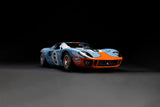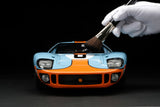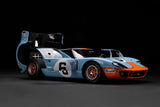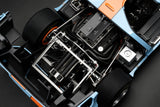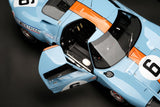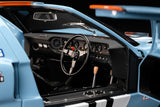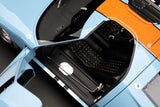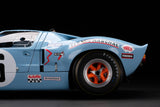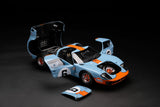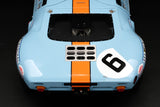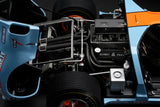- Limited to just 199 pieces
- As raced in 1969 at Le Mans by Jacky Ickx and Jackie Oliver
- Each model hand-built and assembled by a small team of craftsmen
- 1:8 scale model, over 50 cms/20 inches long
- Made using the finest quality materials
- Over 4000 hours to develop the model
- Over 400 hours to build each model
- Thousands of precisely engineered parts: castings, photo-etchings and CNC machined metal components
- Built with the assistance and cooperation of the Ford Archive and Heritage department, and Gulf Oil International
One of the most iconic racing cars of all time, the Ford GT40 was born out of motorsport's most infamous grudge. After failing to secure possession of Enzo Ferrari's much celebrated company, Henry Ford II returned to America empty-handed and declared his desire to crush Ferrari at Le Mans. The result was a car that was to defeat all before it.
Produced for five years between 1964-69, the development of the GT40 was particularly improvised. Despite their tremendous wealth and production capability, Ford as an organisation had precious little racing expertise. Ford negotiated a deal with UK-based Lola Cars owner and chief designer Eric Broadley and dispatched British engineer Roy Lunn back to the UK to take a key role in the project. Overseen by American designer Harley Copp, the team of Broadley, Lunn and ex-Aston Martin team boss John Wyer began working on the new car at the Lola Factory in Bromley. At the end of 1963, the team moved to Slough, at the newly established Ford Advanced Vehicles HQ, under the direction of Wyer. Bruce McLaren, of McLaren Automotive, was hired to evaluate a prototype in August 1963 and then work progressed swiftly, though it was barely finished in time for its unveiling. The first GT40, the GT/101 (the “GT40” moniker came later and was taken from the car's height: it stood at 40 inches tall at the top of the windscreen), was revealed in England on 1 April 1964 and soon after exhibited in New York. Purchase price of the completed car for competition use was ¬£5,200 (or ¬£103k in today's money).
Le Mans testing a few weeks later revealed severe instability issues at high speed; the GT40 could do 200mph (321km/h) but wanted to get airborne above 170mph (273km/h). It's first outings at the Nürburgring, Le Mans and Reims, despite its incredible reputation, were all DNFs. By the end of the year, Wyer, though still building GT40s, handed the job of racing them to the legendary American ex-racer Carroll Shelby. Shelby replaced the 4.2L engine with a 7.0L beast that he already used to great effect in the Cobra, matched to a new ZF transmission. Armed with its new power unit, the GT40 scored its first win at Daytona 1965 before claiming second place at Sebring. Le Mans, though, was a disaster, with all five entries failing to finish due to mechanical issues.
1966 marked the beginning of the GT40 legend. A 1-2-3 victory at Daytona was quickly followed by another victory at Sebring. However, it was the Le Mans crown that Ford coveted. Ford assembled an army for the race that year: nine cars, over 100 personnel with 21 tonnes of spare parts. Ford defeated Ferrari in style, dominating the podium with the top three finishers and becoming the first American manufacturer to emerge victorious at Le Mans. Le Mans wins followed for the GT40 for three more years, establishing the GT40 as one of the most iconic race cars of all time. Ferrari have not won at Le Mans since.
The first 50 models ordered will be accompanied by a Giclée art print of a beautiful Rainer Schlegelmilch photograph shot in the early stages of the 1969 24 Hours of Le Mans. The Giclée print will be on archive quality art paper, with an image size of approximately 30x83cm (12x32in).
This perfect 1:8 scale model of the Ford GT40 is based on the chassis #1075, which was victorious at the 24 Hours of Le Mans in 1969. Driven by Jacky Ickx and Jackie Oliver, the #6 car recorded the real closest-run finish in the history of the Le Mans 24 Hours, and one of the greatest in all of the history of motor racing, beating Hans Hermann's Porsche 908 by just 120 metres (390 feet) after 372 laps. It was a classic underdog story: Porsche had already wrapped up the World Sportscar Championship with three of the ten races to go and were strong favourites to win Le Mans for the first time. 16 Porsches competed, more than a third of the field, and Porsche did indeed lead for 90% of the race. However, the leading 917's gearbox broke at 11 a.m and the Ford of Ickx and Oliver took over the lead. The race ended in a 3-hour sprint, with the Ford battling exhaust problems whilst being pursued by the Porsche 908 of Herrmann and Gérard Larrousse, who themselves contended with mechanical issues affecting the brakes and engine. Ickx knew if he led onto the Mulsanne straight, Herrmann would pass, but he could slipstream past him back again and then hold a lead for the rest of a lap. The cars crossed the finish line with less than a minute to go and so needed to complete one more lap. The Ford had only ever done 23 laps on a tank of fuel, but now suddenly needed to gain an extra lap. Ickx faked a lack of power from fuel starvation, letting Herrmann pass him early on the Mulsanne Straight, before using the slipstream to pass him again just before the end of the 5km straight. Ickx held off Herrmann to cross the line first, denying Porsche for another year.
Even more impressively, the car that crossed the line victorious was not a new car made for that year. In fact, it was the exact chassis that won Le Mans the previous year in the hands of Pedro Rodriguez and Lucien Bianchi. Ickx dedicated the team's victory to previous winner Bianchi, who had been killed earlier in the year. Ickx also emerged the victor after starting the race with a one-man protest against the ‘Le Mans start', after the death of Porsche privateer Willy Mairisse the previous year, by walking to his car and taking his time doing up his belts.
The Ford GT40 1969 Le Mans Winner is limited to just 199 pieces.












